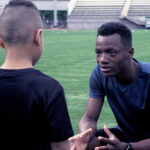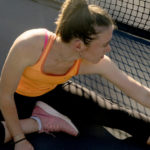Nurturing strength: Tips for parents of female athletes

The drive to succeed can push female athletes to excel at any cost. Female athlete specialist, Dr. Bridget Quinn, talks about what parents and athletes can do to nurture strong bodies and healthy attitudes that will serve the athletes well now and in the future.
What pressures are female athletes under?
Today’s young athletes are under pressure from every angle, athletic, academic, and their own self-expectations. All too often, athletes put tremendous pressure on themselves to perform. The drive to achieve at any cost pushes many to overtrain, which puts their physical and emotional health at risk.
This is a hard world for parents to navigate. They want what’s best for their child, but they don’t want them to miss out on participating in a sport they love.
Why is overtraining a problem? Isn’t it important for kids to experience the benefits of hard work?
Many of the young athletes we see in the Female Athlete Program come to us with musculoskeletal complaints. But on further review, we discover a multitude of other symptoms, such as fatigue, difficulty concentrating, delayed injury healing, and menstrual irregularity. They hit a plateau and no matter how hard they work, their athletic performance is not improving.
Such symptoms can be a red flag that an athlete is not consuming enough calories to support the physical demands on their developing body. This is an opportunity to look at how the athlete is training, how they are fueling (eating or drinking), and what psychosocial stressors they are under. Relative energy deficiency in sport (RED-S) is a term we use to describe the complex interplay of low energy availability on multiple systems in athletes, whether they are male or female.

There are both short- and long-term implications of low energy availability. In the short term, an athlete can be sidelined by an injury, delayed recovery, or fatigue. Those are a few of the short-term impacts. Longer-term, RED-S can interfere with bone mass development at a critical time. Ninety percent of a woman’s bone mass is accrued by the age of 18. Interrupting this process, through overtraining and under-fueling, can increase the risk of stress fractures and early osteoporosis. These are serious consequences that can follow the athlete into adulthood.
How do you talk to athletes and parents when you see signs of energy deficiency?
I sit down with the athlete and family and spend time reviewing the athlete’s schedule. We talk about their academic and athletic load. I ask the athlete to review how they have fueled over the past 24 hours. Do they have any medically diagnosed food allergies or aversions? What is their sleep schedule like? Fatigue is a risk factor for injury, and so many of the kids who come to our program aren’t getting enough sleep. We explore what the athlete wants now and in the future, and how we can help them safely achieve their goals.
What if an athlete tells you that if they dial back their training or eat more, they won’t make the team?
We explore why the athlete feels that way. Does this belief come from messages directed at them or the team? Is it a message they are telling themselves? Are they exercising above and beyond the coach’s prescribed schedule? We also discuss how overtraining and under-fueling can lead to “crashing” and injury, and how this could keep the athlete from performing at their best — or from playing at all!
I’ve seen many young athletes associate “more” with “better,” whereas I emphasize quality over quantity. It’s a matter of trying to strike that right balance of respecting the athlete’s commitment to their sport without sacrificing their health.
Is it normal for female athletes to miss periods?
This is a dangerous misconception. Any interruption in the menstrual cycle, whether it’s missed periods, lighter periods, or infrequent periods, is a sign of a hormonal imbalance that will interfere with healthy bone development. It needs to be addressed right away.
What else should parents know about the physical changes their child might be going through?
Puberty is a time of tremendous change: physically, physiologically, and psychosocially. Besides bone mass development, which is crucial, other physical changes can make puberty an awkward, confusing time for an athlete. Muscular adaptations lag behind skeletal growth. Because of this, there’s a stage when adolescents lose strength, flexibility, and neuromuscular control. It’s normal and temporary, but if the athlete thinks, “Oh no, this is my new normal,” they get scared and frustrated.
Parents, coaches, and trainers can help athletes understand that a temporary dip in strength and coordination is a normal part of adolescent development. They may need to dial back their expectations for a while. But they will come out the other end, and they need to know that too.
What can parents do to foster a positive emotional environment for a female athlete?
One of the most important things parents can do is focus on their child’s strengths — not their weight or physical appearance.
The way parents approach nutrition in the household is also key. As a parent, you have to check your own insecurities or misconceptions about food and body image, and that can be really challenging. Family dinners are are a nice way to connect as a family and can help the athlete both emotionally and in their relationship to food.
Should parents talk to the coach if they’re concerned?
I would first make sure that the athlete is aware and OK with the parent approaching their coach. It may be helpful to take a team approach with the athlete present. The coach may have a different lens into the athlete’s life, so open lines of communication can be helpful. In the best-case scenario, coaches and parents can work together to support the athlete’s physical and emotional health.
This is an example of how an athlete can benefit from a program like ours. Our multidisciplinary team includes physicians and clinical nutritionists who specialize in sports medicine and sports psychology. We help athletes and their families navigate the pressures to perform so that athletes can be their best selves: mind, body, and soul.
Learn more about the Female Athlete Program.
Related Posts :
-

When athletes have bad days: Tips for athletes and parents
No matter how hard they work, every athlete has bad days. Whether it’s a stumble, fumble, or outright loss, ...
-

Relative energy deficiency in sport (REDs): When athletes run on empty
The strength, skill, and speed of Olympic athletes help the rest of us understand human potential in a new light. ...
-

Athletes and fatigue: Why am I so tired?
Working out can boost physical and mental energy. Yet sometimes, athletes feel more fatigued than energized. "Feeling tired after a ...
-

When athletes push too hard: How to screen and when to refer
With the rise in the number and competitiveness of female athletes, overtraining has become a serious health risk for many ...





